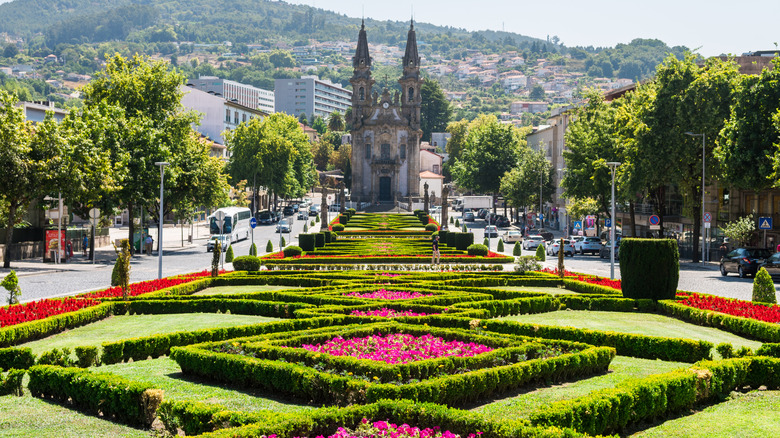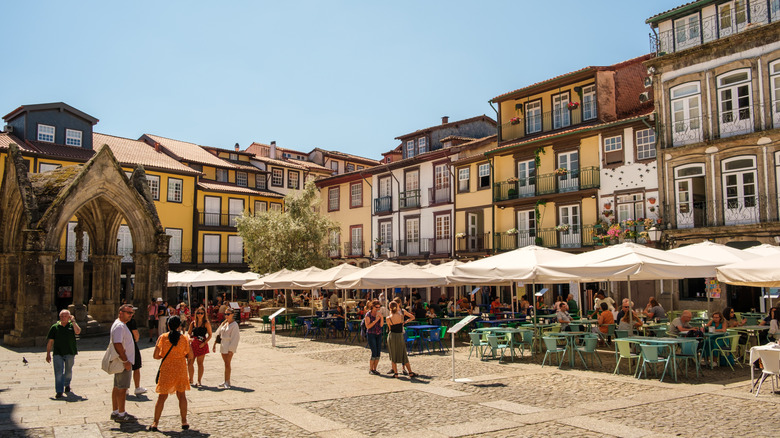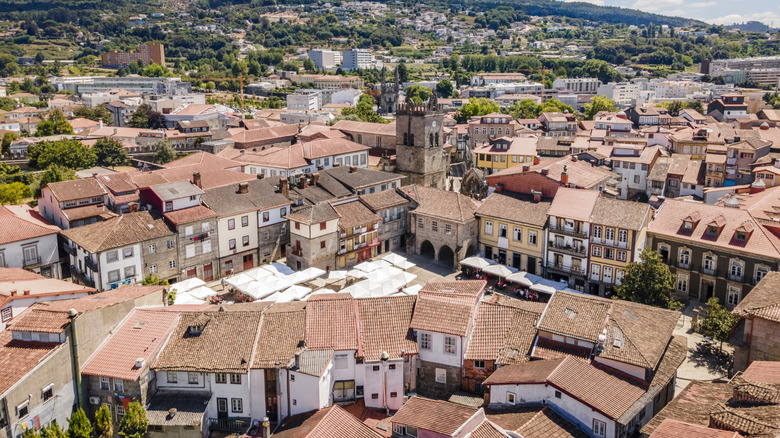'Portugal's Birthplace' Is A Wildly Underrated Medieval Fairytale City With Scenic Streets And Tasty Bites
Portugal tends to get overlooked as a vacation destination in favor of its larger cousin to the east, Spain. Some travelers may decide between visiting Lisbon or Porto but forget about other Portuguese locations. Enter Guimarães, the medieval city northeast of Porto and southeast of Braga informally dubbed the birthplace of Portugal.
It's the history of Guimarães that makes the city so special, grants it its moniker, and ripples forward to the present. During the 12th century, the first king of Portugal, Alfonso I, renovated and occupied the imposing, stark Guimarães Castle that dominates the surrounding cityscape. This is why Guimarães is called Portugal's birthplace. Guimarães' highly walkable downtown is an official UNESCO World Heritage site packed to the gills with a stunning array of museums, monuments, and cloisters interspersed with close-packed, colorful facades and plazas that look lifted from a fairy tale (much like this stylish seaside town on the country's coast). The 1785-built cathedral Igreja de Nossa Senhora da Consolação e Santos Passos stands out, along with the stretch of manicured, geometrically-patterned gardens leading up to it.
Guimarães might not be as super-easy to get to as Lisbon or Porto, but it's still only an hour or so away by train from Francisco Sá Carneiro Airport (aka Porto Airport). And because Portugal is one of the most financially reasonable places to visit in Europe (outside of locations like Bulgaria or Poland), the decision to visit practically makes itself.
Explore the dense, colorful, historic streets of Guimarães
It's easy to see everything Guimarães has to offer because all of its sights are packed into its walkable downtown and UNESCO heritage site. One easy path starts downtown on the north side at Guimarães Castle, where Portugal's first king lived. This mandatory stop is super cheap (about $5.50) and fulfills every medievalist's deepest dreams of walking through castle courtyards, along parapets, and through dining halls fully furnished and decorated to look like you stepped 800 years into the past. Right next door, Ducal Palace is part castle and part walkthrough art museum.
From there, you can work your way south to Guimarães' historic city center. This pretty, provincial downtown is full of al fresco dining in front of brightly painted homes and storefronts. While there, you've got to try vinho verde (green wine), a sparkling wine local to northern Portugal and made from six types of regional grapes. The wine's sharp, sour notes of grapefruit, melon, and lemonade go well with light fare like salads and seafood. There are so many restaurant choices in the area that it's best to just wander and go for whatever catches your eye.
After your midday stop, continue southeast past historic Toural Square. You'll end up at Igreja de Nossa Senhora da Consolação e Santos Passos and its long, manicured garden. It's the perfect stop to end a day in Guimarães. This walkable route takes less than half an hour.
How to fit Guimarães into a trip to northern Portugal
Given the density of Guimarães' offerings, you'd be missing out if you skipped it while traveling to northern Portugal. The city is easily incorporated into a larger trip at the cost of only a day or so, especially because it's located right at the third point of a triangle that includes Porto and Braga.
It makes the most sense to fly into Porto Airport, spend time there, take the train to either Braga or Guimarães, and then go to the other city on the way back to Porto. This route forms a perfect loop. If you want to get out of cities and hit the countryside, you can even incorporate a day trip to this river town famed for its wine. Trains run from Porto to Braga ($17 to $24) and Porto to Guimarães ($17), but between Braga and Guimarães, you'll have to take a bus (around $6). That said, you can also see Lisbon rather than Porto and then head to Guimarães. However, the journey from Lisbon to Guimarães is quite the trek at four and a half hours by train.
Once you're in Guimarães, it's easy to burn through the historic city center in a day, but if you want to stay longer, go for it. There are loads of hotels downtown, all reasonably priced and many below $100 a night. This will give you more time to soak in the sights, chow down on local food, and enjoy vinho verde.


